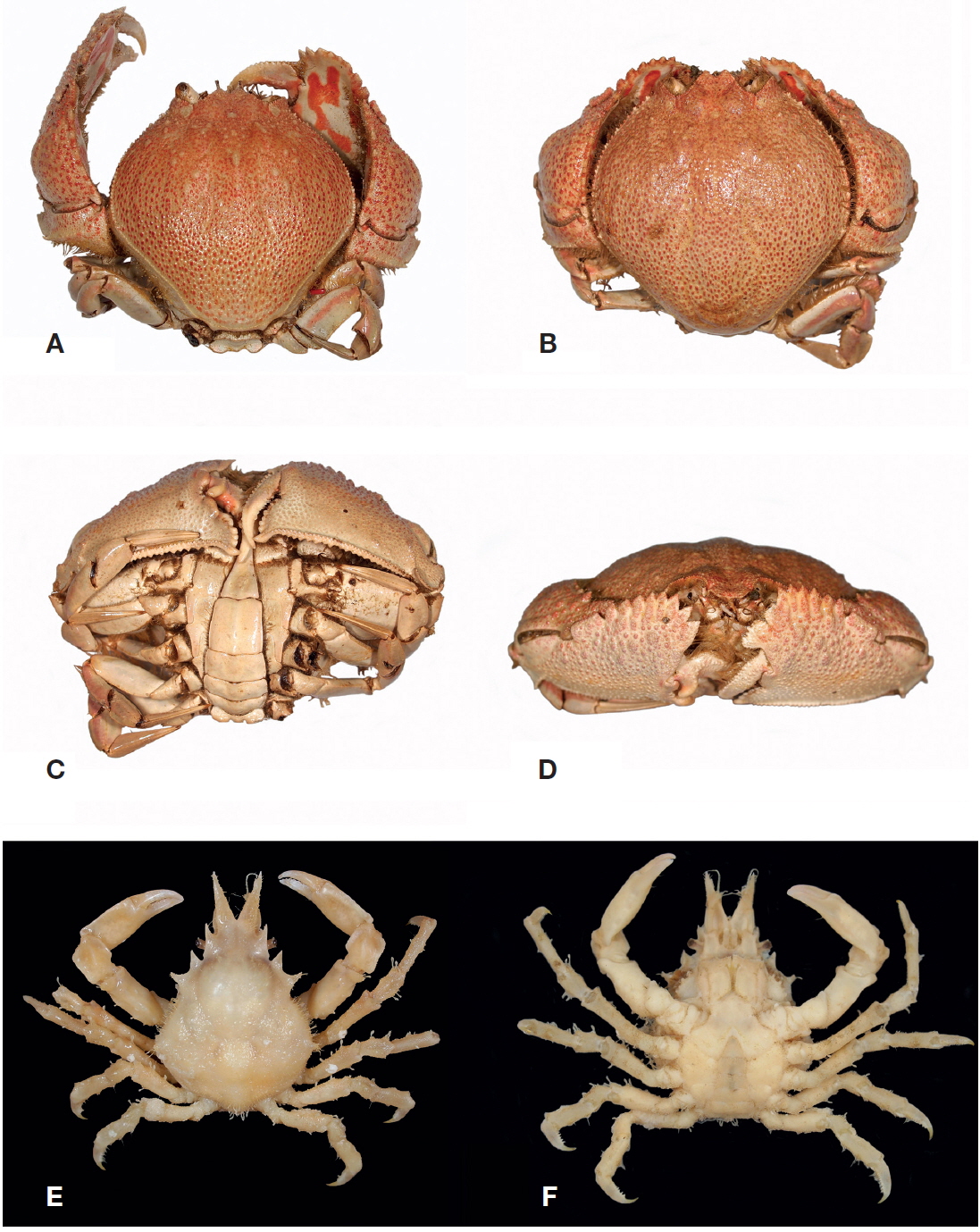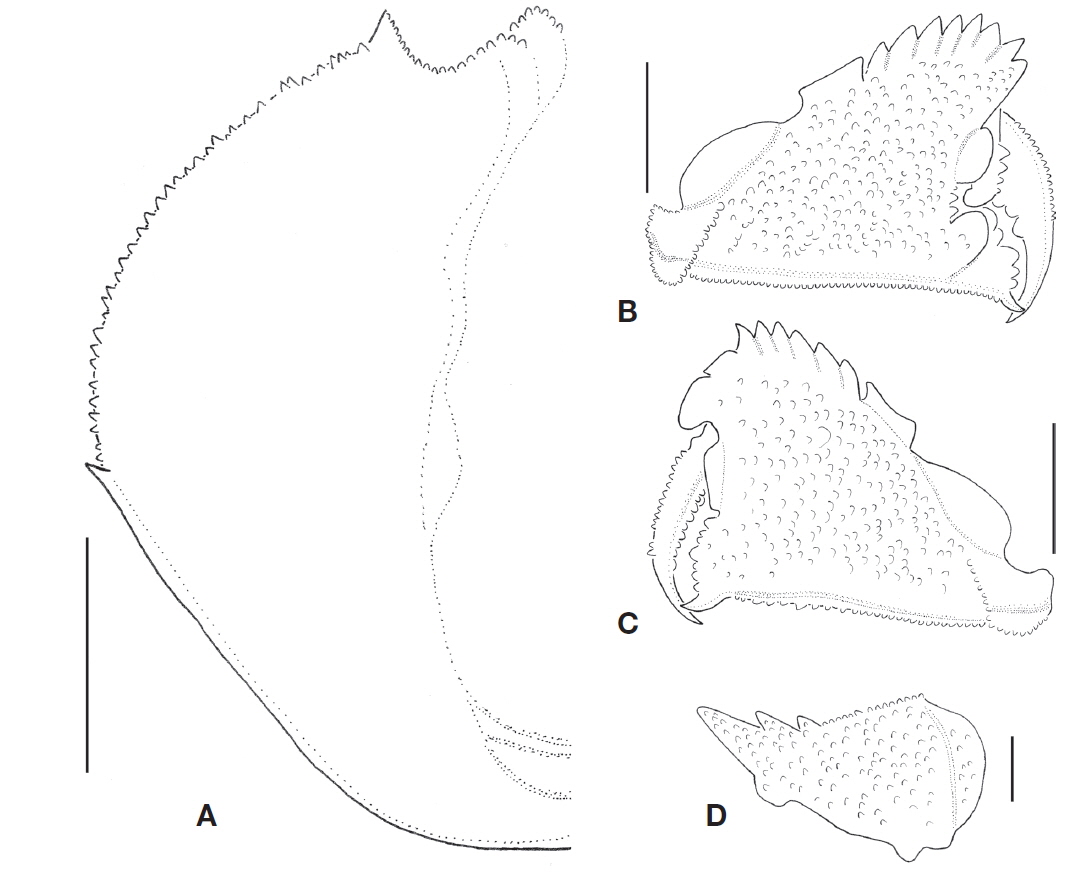



Two species of crabs, Cycloes granulosa and Pugettia vulgaris, are described and illustrated for the first time in Korea. The former is the first species of calappoid genus Cycloes and characterized by having a minute lateral spine on the margin of carapace. The latter is a species of majoid crab and similar to P. pellucens. However, it can be distinguished by shorter rostral spines, a smaller hepatic spine, and a carapace entirely covered with short setae. In Korea the calappoid crab now includes seven species of three genera (Calappa, Mursia, and Cycloes) and the majoid genus Pugettia consists of six species.
During a visit to the Folklore and Natural History Museum in Jeju Special Self-governing Province, the authors found in its arthropod collection dried specimens of
The majoid genus
Specimens were examined under a Leica EZ40 microscope (Leica Microsystems, Wetzlar, Germany) and digital photographs of crabs taken using an Olympus E-30 camera (Olympus, Tokyo, Japan). The following abbreviations are used in the present study: CL (carapace length) from the tip of rostrum to the posterior dorsal margin of the carapace, CW (carapace width) across the widest point of the carapace excluding branchial spine, and in majoid crab PCL (postrostral carapace length) carapace length excluding rostrum. Measurements were made by using digital vernier caliper (CD-15APX, Mitutojo, Kawasaki, Japan) to 0.1 mm. The brachyuran classification follows that of Ng et al. (2008). All the specimens are deposited at the corresponding author’s collection of Silla University, Busan.
Superfamily Calappoidea De Haan, 1833
Family Calappidae De Haan, 1833
Not
Material examined. 2♀♀ dried, Korea: Jeju Special Self-Governing Province, Hallim-eup, Jeju-si, Hallim Port, 28 Oct 2007, coll. Yang KC.
Description. Carapace (Figs. 1A, B, 2A) convex, longitudinally ovate, slightly longer than broad. Dorsal surface densely granulate, with longitudinal rows of low tubercles anteriorly; regions indistinct except furrows bordering cardiac region. Front narrow (Fig. 1A, B, D), with 2 triangular teeth. Anterolateral margin (Figs. 1A, B, 2A) granulate; lateral spine minute, indistinct; posterolateral margin sharply convergent, minutely granulate.
Eye (Fig. 1A, B, D) filling orbit; eyestalk short, smooth, cornea large; orbital margins with long plumose setae; supraorbital margin swollen medially.
Chelipeds (Figs. 1, 2B-D) massive, densely granulate, subequal in size. Merus (Fig. 1A, B, D) with lanceolate tooth distally. Upper margin of carpus (Figs. 1A, B, D, 2D) with 3 teeth increasing in size distally. Palm (Figs. 1A, B, D, 2B, C) crested on upper margin, cut into 9 teeth; outer surface densely granulate, with larger granules below crest; lower margin with 2 parallel rows of acute tubercles, bearing keellike lobe proximally. Movable finger (Figs. 1C, D, 2B, C) granulose on outer surface, with acute tubercles on upper margin; right one with proximal molariform tooth fitting into shallow depression.
Ambulatory legs (Fig. 1A-C) smooth, laterally compressed; dactyli long, styliform.
Abdomen of female (Fig. 1C) with 6 segments; segment 2 with bifissured, medially concave crest. Telson (Fig. 1C) triangular, slightly longer than abdominal segment 6.
Habitat. The crab was found on the sandy bottom at 5-100 m in depths (Minemizu, 2000).
Distribution. Singapore, Vietnam, Taiwan, China, Japan, Philippines, and now Korea.
Remarks. These crabs are the first species of the genus
Superfamily Majoidea Samouelle, 1819
Family Epialtidae MacLeay, 1838
Subfamily Epialtinae MacLeay, 1838
Genus
Material examined. 5♂♂, Korea: Gangwon-do, Gangneung- si, Jumunjin-eup, 31 Mar 2011, SCUBA at 25 m depth, Lee SH.
Description. Carapace (Figs. 1E, 3A) elongated pear-shaped; rostrum with 2 spines, which divergent at 50°, covered with hooked setae, approximately 0.3 PCL; dorsal surface entirely covered with club-shaped setae; regions relatively indistinct; gastric, cardiac, and intestinal regions convex, without tubercle; branchial region slightly convex, without tubercle; hooked setae on protogastric region and anterolateral margin; tufts of a few longer setae on mesogastric, cardiac, branchial, and intestinal regions and tips of hepatic and epibranchial spines; lower margin with 2 small acute tubercles anterolaterally; preorbital spine (Figs. 1E, F, 3A, B) acute; orbital hiatus between blunt antorbital angle and postorbital spine U-shaped; postorbital spine triangular, subequal to or slightly smaller than hepatic spine; hepatic spine fused at base with postorbital spine, tip slightly curved; epibranchial spine small, acute.
Eye (Figs. 1E, F, 3B) non-retractile, orbit incomplete.
Basal antennal article (Fig. 3B) with distal spine on outer lateral margin; antennal peduncle consisting of 2 articles; ultimate article shorter than penultimate article, proximal end as broad as distal end.
Pterigostomial region (Fig. 3B) with 4 small tubercles.
Third maxilliped (Fig. 3C): Ischium subrectangular, about 1.2 times longer than broad, inner margin with setae and spinules, antero-inner margin produced; merus with setae on margins; dactylus setose. Outer margin of exopod with setae and spinules.
Chelipeds (Figs. 1E, F, 3A, D, E) equal in size. Merus prismatic; upper crest distinct, with 2 small teeth proximally and larger tooth subdistally; lower surface with 3 small tubercles; inner and outer margins without tubercle. Carpus sharply crested on inner and outer margins, upper surface with shorter crest including 2-3 tubercles. Palm crested on upper surface.
Ambulatory legs (Figs. 2, 3A, F, G) with short dense setae, scattering of longer setae; each merus with distal tooth; each carpus with 2 ridges on upper surface; each dactylus with 2 rows of spinules on posterior margin.
Abdomen of male (Fig. 3H) with 6 segments.
Gonopod 1 (Fig. 3I, J) relatively stout; distal part triangular; lateral lobe broad, triangular; 2 medial lobes slender; dorsal lobe (Fig. 3J) approximately 1.5 times longer than ventral lobe.
Habitat. These crabs were found in a scallop farm.
Distribution. Japan and now Korea.
Remarks. These specimens agree well with those of
Including the present study, six species of the genus
Key to species of the genus
Eye with incomplete orbit. Basal antennal article short, truncate. Carapace subtriangular or pear-shaped, rostrum with 2 slender spines, preorbital and postorbital spines distinct, hepatic and branchial margins produced with spine. Chelipeds prismatic in meri. All abdominal segments distinct in both sexes.
1. Postorbital spine and hepatic lobe fused as wing-shaped plate ··························································
- Postorbital spine and hepatic lobe not fused as wing-shaped plate ············································································ 2
2. Cardiac region of carapace with prominent spine ············· ····································································
- Cardiac region of carapace without prominent spine······ 3
3. Postorbital spine much smaller than hepatic spine ········· 4
- Postorbital spine subequal to hepatic spine ···················· 5
4. Carapace subtriangular ······················
- Carapace elongated pear-shaped ··········
5. Carapace regions well defined ··········
- Carapace regions not defined ·················




